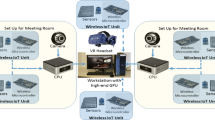Abstract
In this paper, a novel approach for creating 3D models of building scenes is presented. The proposed method is fully automated and fast, and accurately reconstructs both outdoor images of a building and indoor scenes, with perspective cues in real-time, using only one image. It combines the extracted line segments to identify the vanishing points of the image, the orientation, the different planes that are depicted in the image and concludes whether the image depicts indoor or outdoor scenes. In addition, the proposed method efficiently eliminates the perspective distortion and produces an accurate 3D model of the scene without any intervention from the user. The main innovation of the method is that it uses only one image for the 3D reconstruction, while other state-of-the-art methods rely on the processing of multiple images. A website and a database of 100 images were created to prove the efficiency of the proposed method in terms of time needed for the 3D reconstruction, its automation and 3D model accuracy and can be used by anyone so as to easily produce user-generated 3D content: http://3d-test.iti.gr:8080/3d-test/3D_recon/













Similar content being viewed by others
References
Aguilera DG, Gómez Lahoz J, Finat Codes J (2005) A new method for vanishing points detection in 3D reconstruction from a single view. International Workshop on 3D Virtual Reconstruction and Visualization of Complex Architectures (3D-ARCH ’05), Venice
Canny J (1986) A computational approach to edge detection. IEEE Trans. Pattern Analysis and Machine Intelligence
Criminisi IR, Zisserman A (2000) Single view metrology. Int. J. Computer Vision, 40(2):pp 123–148. http://portal.acm.org/citation.cfm?id=365888
Debevec PE (1996) Modeling and rendering architecture from photographs. PhD thesis, University of California at Berkeley, Computer Science Division, Berkeley CA
Delage, HL, Ng AY (2006) A dynamic Bayesian network model for autonomous 3D reconstruction from a single indoor image. Computer Vision and Pattern Recognition, IEEE Computer Society Conference on, 2: pp 2418-2428. http://www.stanford.edu/~hllee/cvpr06_3dReconIndoorScene.pdf
Google Sketch Up. http://sketchup.google.com/
Hartley R, Zisserman A (2003) Multiple view geometry in computer vision. Cambridge University Press, pp 47–57
Hoiem D (2005) Alexei A. Efros and Martial Hebert. Automatic Photo Pop-up. ACM SIGGRAPH
Hoiem D, Efors A, Hebert M (2005) Geometric context from a single image. In Proceedings of IEEE Conference Computer Vision and Pattern Recognition. http://www.cs.uiuc.edu/homes/dhoiem/publications/Hoiem_Geometric.pdf
Horry Y, Anjyo K-I, Arai K (1997) Tour into the picture: using a spidery mesh interface to make animation from a single image. Proceedings of the 24th annual conference on Computer graphics and interactive techniques, pp 225-232. [doi:10.1145/258734.258854]
Huang J, Cowan B (2009) Simple 3D Reconstruction of Single Indoor Image with Perspective Cues. crv, pp.140-147. Canadian Conference on Computer and Robot Vision. http://www.computer.org/portal/web/csdl, doi:10.1109/CRV.2009.33
Illingworth J, Kittler J (1988) A survey of the hough transform. Comput Vis Graph Image Process 44(1):87–116
Lee DC, Hebert M, Kanade T (2009) Geometric reasoning for single image structure recovery. IEEE International Conference on Computer Vision and Pattern Recognition (CVPR), June. www.cs.cmu.edu/~dclee/pub/cvpr09lee.pdf
Liebowitz D (1999) Antonio Criminisi, and Andrew Zisserman. 1999. Creating Architectural Models from Images. In Proc. EuroGraphics, vol 18. http://www.robots.ox.ac.uk/~vgg/publications/papers/liebowitz99.pdf.
Liebowitz D (2001) Camera calibration and reconstruction of geometry from images. Merton College Robotics Research Group Department of Engineering Science University of Oxford Trinity Term 2001. http://www.robots.ox.ac.uk/~vgg/publications/papers/liebowitz01.pdf
Rother (2000) A new approach for vanishing point detection in architectural environments. In BMVC, pages 382-391. www.bmva.org/bmvc/2000/papers/p39.pdf
Rother C (2002) A new approach to vanishing point detection in architectural environments. Image Vis Comput 20(9–10):647–655
Saxena A, Chung SH, AY Ng (2005) Learning depth from single monocular images. In Neural Information Processing Systems (NIPS). http://citeseerx.ist.psu.edu/viewdoc/summary?doi=10.1.1.72.8799
Saxena A, Sun M, Ng A (2007) Learning 3-D Scene Structure from a Single Still Image. In: Proc. of ICCV workshop on 3D representation for Recognition
Saxena A, Chung SH, Ng AY (2007) 3-d depth reconstruction from a single still image. IJCV
Van den Heuvel FA (1998) Vanishing point detection for architectural Photogrammetry. Int Arch Photogram Rem Sens 32(5):652–659
Acknowledgments
This work was supported by the EU FP7 project 3DLife Network of Excellence project, ICT-247688.
Author information
Authors and Affiliations
Corresponding author
Rights and permissions
About this article
Cite this article
Vouzounaras, G., Daras, P. & Strintzis, M.G. Automatic generation of 3D outdoor and indoor building scenes from a single image. Multimed Tools Appl 70, 361–378 (2014). https://doi.org/10.1007/s11042-011-0823-0
Published:
Issue Date:
DOI: https://doi.org/10.1007/s11042-011-0823-0




